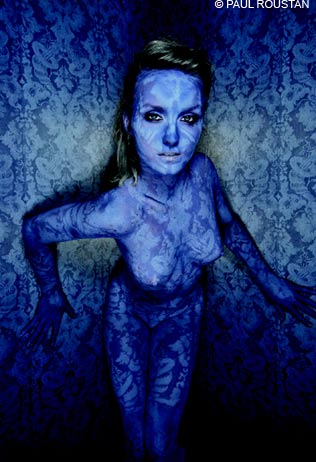
FASCINATING: Roustan's Fleur de lis.
Model: Brenna |
Tom Lundquist of Santa Monica, California, imagines a gleaming plastic fantastic world in 16 printed computer illustrations from his Poissons de Chant(Singing Fish) series at Moses Brown School's Krause Gallery (250 Lloyd Avenue, Providence, through January 30).
They seem like razzle-dazzle outtakes from a goofball noir video game adventure. A black-and-white girl walks a tightrope outside the "Gill Club." A giant fish in a giant fish bowl, a prim woman with French braids and three sheep sing into microphones inside the nightclub as black-and-white girls swing from the ceiling. Paper lanterns slide along cables toward a lighthouse, as sheep watch the prim woman exit the building. A man swarmed by bees ("the Bee's agent") holds up an image of the prim woman standing at the edge of a pond as a fish pokes above the water to watch her.
The story, as far as I could decipher, is about assembling a nightclub singing act featuring the woman, sheep and giant fish. Lundquist's website explains that the prints depict "the adventures of a mythical troupe of singing fish from Montreal." The notion is super cheesy — I can't help thinking of those rubber robot fish that sing tinny versions of "Take Me to the River." But I'm curious about the digital territory that Lundquist inhabits.
A number of artists have been making art inspired by video games and computer graphics in recent years. The stuff that most sticks in my head has a retro, flat, pixilated style. Perhaps most famously, Cory Arcangel of Brooklyn hacked Nintendo games to reduce entertainments like Super Mario Bros. to just its white clouds scrolling across a bliss-out digital blue sky. The Providence collective Paper Rad (which has collaborated with Arcangel) makes eye-popping paintings and digital animations that resemble the chunky graphics of '80s video games. At AS220 in June, Ben Fino-Radin of Providence exhibited a plastic-canvas needlepoint sculpture of an old Mac, plus a wall arrangement of needlepoint versions of desktop icons like hourglasses and pointing hands. The French artist Space Invader has covered walls around the world with tiles arranged to look like aliens from the namesake 1978 video game.
I've seen stuff that has evokes the look of more recent games — like photos of game landscapes or Mark Skwarek's interactive apocalyptic digital environment Children of Arcadia, which he exhibited at the RISD thesis show last spring. But little of it matches recent games like Grand Theft Auto, Spore, or BioShock for interest or complexity. There's undeveloped potential for art here.
Lundquist's visions are rendered in vivid detail, but the effect is hampered by his silly subject. Still I find myself lingering over his characters' plastic textures — like the disconcertingly synthetic 3D renderings familiar from recent games and more "realistic" computer-animated films like the 2007 movie Beowulf. This plasticness, rather than being a distraction (or merely a distraction), is the soul of these entertainments. Perhaps plasticness will become the essential characteristic of art inspired by recent digital entertainments, much the way art inspired by retro games' builds off their signature 2D graphics.